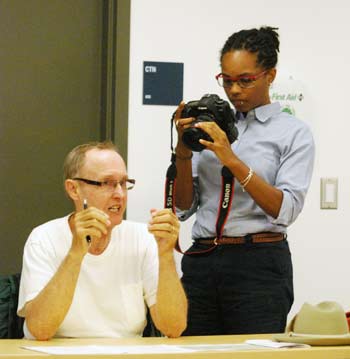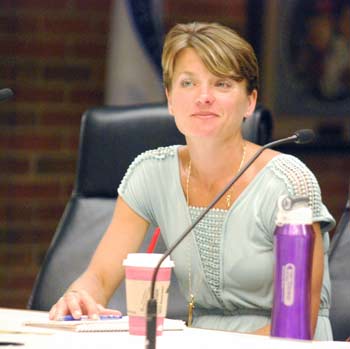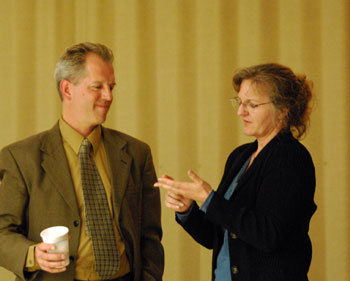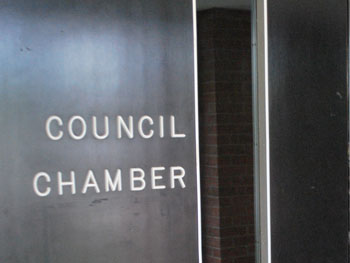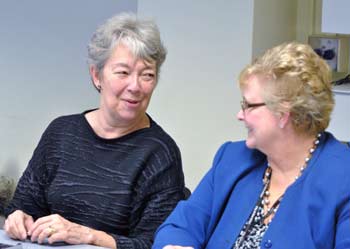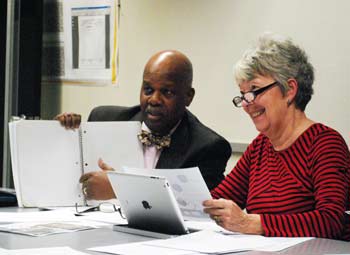Art Commission Supports “PowerArt” Project
Ann Arbor public art commission meeting (Sept. 25, 2013): The main item on this month’s AAPAC agenda was a request to partner with the Ann Arbor Downtown Development Authority on a project called “PowerArt,” to be administered by the Arts Alliance.
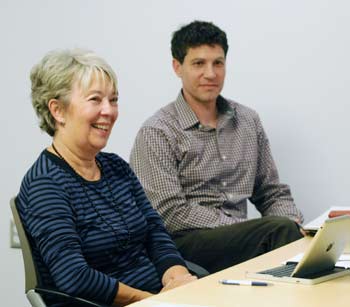
Ann Arbor public art commissioners Marsha Chamberlin and Devon Akmon. Akmon is AAPAC’s newest member, and was attending his first commission meeting on Sept. 25. Chamberlin is the longest-serving commissioner. (Photos by the writer.)
The project would involve wrapping about 40 traffic signal boxes in the DDA district with vinyl printed replicas of artwork. The initial pilot phase would focus on 14 boxes at a total cost of $41,000, to be split between the city and the DDA. That cost includes a 30% administrative fee paid to the Arts Alliance, which is based in Ann Arbor. Another $80,000 would be needed for the final phases.
Deb Polich, executive director for the Arts Alliance, told commissioners that the DDA board is expected to vote on the project at its Oct. 2 meeting.
Commissioners were supportive of the project, but concerned about how to approach the funding, given constraints tied to the remaining Percent for Art funds. “I want to make sure we don’t step in something that we then get slapped for,” Marsha Chamberlin said.
Ultimately, commissioners unanimously voted to approve participating in the PowerArt project, contingent on the city’s legal review of potential funding sources.
AAPAC also authorized allocations for other projects that have been discussed for several months. They approved $10,000 for a community project called Canoe Imagine Art, and $5,000 for a Coleman Jewett memorial at the Ann Arbor farmers market. Both of these projects will rely on grants and private fundraising for the majority of their budgets.
Action on three other projects was tabled, as commissioners wanted more detailed proposals before allocating funds. Those projects were: (1) artwork for a roundabout at State & Ellsworth; (2) a community art project at Arbor Oaks Park, adjacent to Bryant Elementary School; and (3) a proposal for enhancing the fence along the south side of Scio Church Road, between Maple and Delaware.
These projects prompted some discussion about broader issues, included the process that AAPAC uses to vet proposals. Ashlee Arder, one of the newer commissioners, advocated for continuing to develop a more structured approach. “I do think we need to have a larger conversation or retreat about who we are and what we’re trying to do here,” she said.
The commission has been grappling with a transition to a new funding model for public art, after the city council voted to eliminate the previous Percent for Art mechanism this summer. That model set aside 1% of the budget for each of the city’s capital projects for public art – up to a cap of $250,000. Because that money was taken from restricted funds – such as millage funds for parks or street improvements – a thematic link must exist between the funding source and the public art expenditure. About $840,000 in Percent for Art funds remain available for projects, but there will be no additional Percent for Art funding.
Instead, the city has adopted an approach in which city staff will work with AAPAC to determine whether a specific capital improvement should have enhanced design features “baked in” to the project – either enhanced architectural work or specific public art. The funding for any of the enhanced features would be included in the project’s budget and incorporated into the RFP (request for proposals) process for the capital project. There is also an increased focus on private fundraising and partnerships.
On Sept. 25, commissioners also received several updates from Aaron Seagraves, the city’s public art administrator. He reported that a reception is planned for Thursday, Oct. 10 at 6 p.m. to dedicate the hanging sculpture Radius, located in the Justice Center lobby next to city hall. Oregon artist Ed Carpenter is expected to attend.
And two finalists for artwork at Argo Cascades – Jann Rosen-Queralt of Maryland and Mags Harries & Lajos Heder of Cambridge, Mass. – will be coming to town on Oct. 17 to present their conceptual designs to the public. A task force will make a recommendation to AAPAC on which of the artists to select for the project.
The Sept. 25 meeting was the first one for AAPAC’s newest member, Devon Akmon. Appointed by the Ann Arbor city council on Sept. 3, 2013, Akmon is director of the Arab American National Museum in Dearborn. [Full Story]







